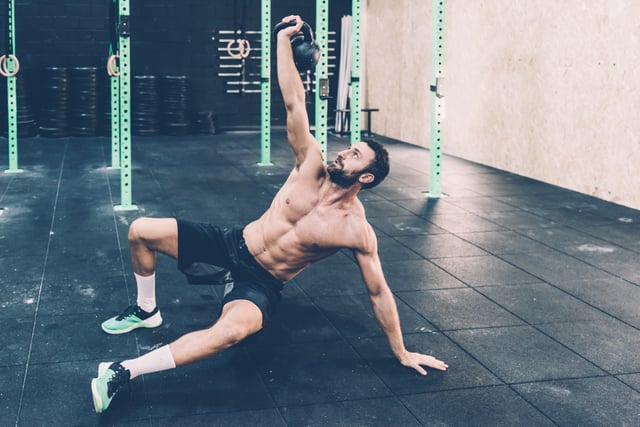
How the get-up will make you strong
I had been using kettlebells for a while at home. I performed the double kettlebell swing and other exercises in a circuit without any formal instructions to support my marathon running. Once I started with Stronglifts 5x5 I ditched the kettlebells for a long time only working with the barbell. After reading simple and sinister by Pavel Tsatsoulin I rediscovered the beauty of the kettlebell as a warm up and general strength builder for powerlifting.
How to get-up
The instructional material on the get-up is not hard to come by. In the internet age, you will find some bro (including me) who is full of advice on fitness at the tips of your finger. I personally found that good sources around the Kettlebell come from Pavel Tsatsoulin and his crew around Strongfirst.
Books to learn about the get up are Power to the people, enter the kettlebell and simple and sinister. For instructional purposes, you will find the Strongfirst videos included in this post.
For me personally, there were some things which are important for the get up that is not mentioned in the books.
- Kettlebells from Tesco / Plastic Kettlebells
- Training on tiles
- Training on carpet
- Kettlebells while traveling
- Areas which can get injured
- Getting to starting position
- Weak wrists
- Perform the positive and the negative
- Alternative hand creme
First and furthermost some comments on the kettlebell you will use. My wife got me two 14kg kettlebells made out of plastic a couple of years ago. They had little stoppers on the bottom so that you were able to do planks and rows with them. While good at the time, these plastic kettlebells are not ideal for doing Turkish get ups.
The plastic kettlebells are usually bigger than their metal counterparts and have a different feel to them. I trained with them in Kerry when my wife and I went on our mini-moon and it was very different to what I had gotten used to with the 24kg kettlebell back in my local gym. If you can avoid it, leave the plastic kettlebell and get proper iron ones straight off the bat. Good options are "perform better", rogue kettlebells & the Valery Federenko brand.
In case you are planning to train at home there are some things to consider when training on tiles. The metal kettlebells can very likely damage the tiles and then you need to replace them. So either use a mat or make 100% sure that you are in control of the kettlebell until the very end of the get-up . This will most likely mean to start a bit lighter than you would have expected. It is wise to take this approach with any kind of overhead lift as losing control usually spells disaster in these scenarios. I would also advise a mat to protect your knees. Without one they take a beating on the hard tiles.
If you are training on the carpet there is a lower likelihood of destroying your home by bouncing kettlebells of the floor but a bigger likelihood to hurt yourself if you do not use a mat. Carpet burn is nasty and if you do the sweep to place your knee for the get up you might end up with some unnecessary burns. Therefore, also here, I would advise you to use a mat for your get ups to prevent this.
There is only one real downside to kettlebells as a home gym compared to other options like k-bands and jumping ropes, you can not get them through customs. If you are planning on taking your kettlebell somewhere abroad to train, good luck with that. Unless you are filthy rich and want to pay the extra weight, that is not really an option. Luckily enough you will find kettlebells in most local gyms and hotels. Based on my experience you find up to 24kg in local gyms and up to 16kg in hotels if there are any kettlebells. You won't find any 32kg options or above except in really rare cases. So once you start to scale make yourself familiar with overclock swings and varying the intensity within the set. These techniques are a good fit for more experienced grieviks and can turn 24kg kettlebells into very challenging beasts indeed.
Another point which is not mentioned in the books for beginners is that it is likely that you will hurt the area on which the kettlebell rests for the get up in the first month. Especially if you are already strong from powerlifting and start out with 24kg or more this is likely to happen. The tissue and the bone are not used to the beating of a kettlebell. Take caution here to avoid breaking your underarm or the skin. Take a break as necessary to recover. This effect (redness, a bit of swelling) should subside once you improved the strength of your wrists and you have gotten more resilient in the affected areas.
The beginners of the trade might also not be used to keeping their wrist straight. In this case, the preferable option is to lower the weight and progress from there. Another option is to help with the other hand to get the kettlebell in position after the press up. Whatever option you choose, if you want to do it by the book there is no intervention from the other hand allowed once you have the kettlebell in starting position.
It is very tempting to drop the kettlebell from the highest point while holding onto it when you start and skip the negative. Don't do this. It deprives you of a good chance to become a better, more disciplined person. It is a cheat and it exposes you to more risk of crushing your skull or foot with a kettlebell. Get down the same way you got up.
Pavel recommends hand creme which is highly debated as there are some dubious components in it. I have been using Neutrogena which is widely available in Europe as a good, reasonably priced alternative, to minimize calluses and bleedings.
To perform the get up perfectly I will refrain from writing detailed instructions. These are better obtained from the master himself Pavel and via video as followed:
Asymmetrical
The get up will make you strong in ways that other barbell exercises will not as it is an asymmetrical exercise. If you have challenges with any of the barbell movements (Bench press, Squat, Deadlift) asymmetrical exercises leg the Bulgarian split squat, single leg deadlift and the Turkish get up are great movements to get into your repertoire as accessory movements.
As you only use one arm in the movement your body is forced to coordinate and balance the load. The idea is also to perform this at high loads which are challenging ( always err on the side of caution). This usually leads to higher activation of the nervous system and stabilizers in your body. These are usually activated less when you use machines, isolated exercises or symmetrical free weight exercises using dumbbells and/or barbells.
Functional
There are not a lot of other exercises which are as functional as the Turkish get up when it comes to strength. It is one of the few exercises in which you can start from the ground up to bring a weight from the floor to over your head in a safe way. In addition, it is less complex to learn compared to the Olympic lifts which are similar from a functional perspective. The challenge with the snatch and the clean and jerk is that these movements incorporate a lot of acceleration and deceleration of the load which brings injury risk through the roof. Especially for untrained and inexperienced individuals.
The get-up works statically while still challenging you to bring the load the full way. You can teach and perform this move at any age and with a wider array of fitness levels than the Olympic lifts as these require more flexibility and technique.
Heavy load
The get up will make you strong because it is heavy. It is not for sissies and a powerful exercise. It has been in the repertoire of strongmen for centuries. The satisfaction of getting up for the first time with a 32kg kettlebell can not be matched by a simple overhead press. It is way more exciting and instructive than that.
Unforgiving
Another good thing about the get up which will help you to get stronger, in general, is that it is very instructive for bad technique. If the kettlebell gets out of the ideal groove you will directly notice. This usually happens as the weight starts traveling because you are shifting your shoulders and/or feet too much. You will notice when you did something wrong and it is more unforgiving than most of the other overhead movements you can do in the gym but not as fatal as the Olympic lifts (if you do anything wrong there with instructive weight, you are in for a lot of trouble).
Progression
With the kettlebell, you can progress in 4kg increments. Men will usually start with 16 - 24kg while women start with 8 - 16kg depending on fitness level. The next stages are 28kg, 32kg, 36kg, 40kg, 44kg and 48kg. Once you can perform a get up with half of your body weight you have entered the realm of iron manhood.
Conclusion
I regret that I did not incorporate heavy get ups earlier in my road to strength. You will learn to appreciate them as a routine on its own to get strong, if your main focus is not strength or as a great warm up for heavy OH presses, squats and deadlifts if you take the iron game very serious. For me, I can not wait for the days when I start lifting 48kg over my head in a controlled manner with one arm. Exciting times ahead.
Further reading
- 30 Tips on how to get stronger for lifting
- 3 easy ways for marathoners to get stronger and
more agile - 5 secrets from Pavel Tsatsoulin and Jim Wendler to make you stronger
- 5 steps to run faster, get stronger and be smarter
- 5 Strongmen you should know
- 5 tips to get stronger faster
- 7 websites to stay fit and strong
- Better breathing makes your squat stronger
- Do you need protein to get stronger
- How to get 10% stronger in six weeks
- How to kettlebell swing to get amazingly strong
- How your body gets stronger for CrossFit and powerlifting
- Selected quotes from Deadlift Dynamite that will make you stronger
- Selected quotes from simple and sinister that will make you stronger
- Sore today, strong tomorrow with a squat workout
- Try this deadlift thing to get strong like bull

